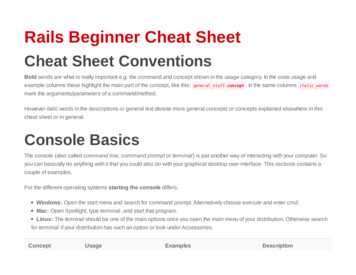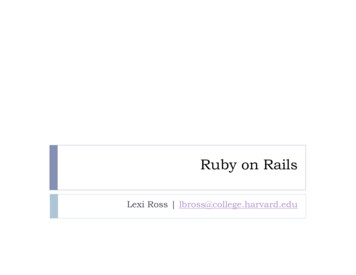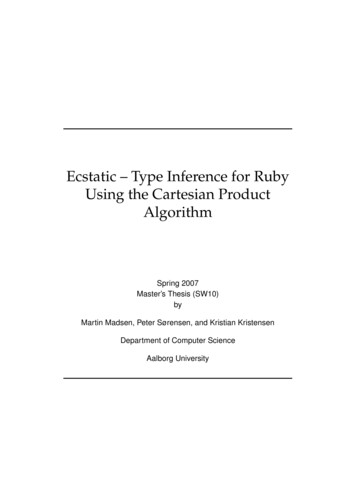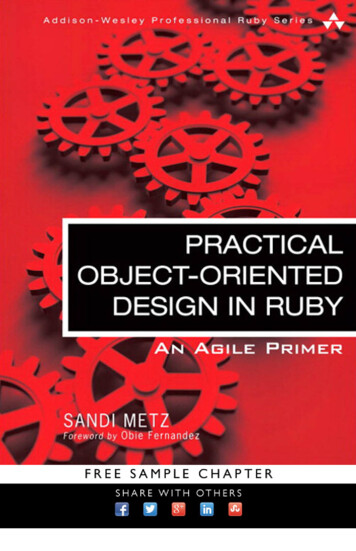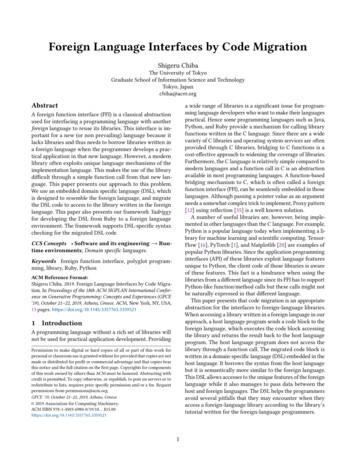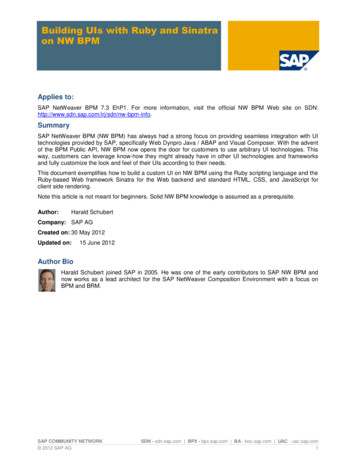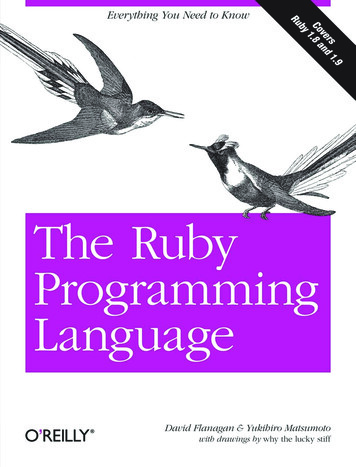
Transcription
The Ruby Programming Language
Other resources from O’ReillyRelated titlesoreilly.comRuby Cookbook Learning RubyAdvanced RailsRails Cookbook Ruby Pocket ReferenceAjax on RailsRuby on Rails: Up andRunningoreilly.com is more than a complete catalog of O’Reilly books.You'll also find links to news, events, articles, weblogs, samplechapters, and code examples.oreillynet.com is the essential portal for developers interested inopen and emerging technologies, including new platforms, programming languages, and operating systems.ConferencesO’Reilly & Associates brings diverse innovators together to nurture the ideas that spark revolutionary industries. We specializein documenting the latest tools and systems, translating the innovator’s knowledge into useful skills for those in the trenches.Visit conferences.oreilly.com for our upcoming events.Safari Bookshelf (safari.oreilly.com) is the premier online reference library for programmers and IT professionals. Conductsearches across more than 1,000 books. Subscribers can zero inon answers to time-critical questions in a matter of seconds.Read the books on your Bookshelf from cover to cover or simply flip to the page you need. Try it today for free.
The Ruby Programming LanguageDavid Flanagan and Yukihiro MatsumotoBeijing Cambridge Farnham Köln Paris Sebastopol Taipei Tokyo
The Ruby Programming Languageby David Flanagan and Yukihiro Matsumotowith drawings by why the lucky stiffCopyright 2008 David Flanagan and Yukihiro Matsumoto. All rights reserved.Printed in the United States of America.Published by O’Reilly Media, Inc., 1005 Gravenstein Highway North, Sebastopol, CA 95472O’Reilly books may be purchased for educational, business, or sales promotional use. Online editionsare also available for most titles (http://safari.oreilly.com). For more information, contact our corporate/institutional sales department: (800) 998-9938 or corporate@oreilly.com.Editor: Mike LoukidesProduction Editor: Sarah SchneiderProofreader: Sarah SchneiderIndexer: Joe WizdaCover Designer: Karen MontgomeryInterior Designer: David FutatoIllustrators: Rob Romano and why the lucky stiffPrinting History:January 2008:First Edition.Nutshell Handbook, the Nutshell Handbook logo, and the O’Reilly logo are registered trademarks ofO’Reilly Media, Inc. The Ruby Programming Language, the image of Horned Sungem hummingbirds,and related trade dress are trademarks of O’Reilly Media, Inc.Java and all Java-based trademarks are registered trademarks of Sun Microsystems, Inc., in the UnitedStates and other countries. O’Reilly Media, Inc. is independent of Sun Microsystems.Many of the designations uses by manufacturers and sellers to distinguish their products are claimed astrademarks. Where those designations appear in this book, and O’Reilly Media, Inc. was aware of atrademark claim, the designations have been printed in caps or initial caps.While every precaution has been taken in the preparation of this book, the publisher and authors assumeno responsibility for errors or omissions, or for damages resulting from the use of the information contained herein. The drawings on the chapter title pages were drawn by why the lucky stiff and are licensedunder the Creative Commons Attribution-ShareAlike 3.0 License. To view a copy of this license, /legalcode or send a letter to Creative Commons, 171 2ndStreet, Suite 300, San Francisco, California, 94105, USA.TMThis book uses RepKover , a durable and flexible lay-flat binding.ISBN-10: 0-596-51617-7ISBN-13: 978-0-596-51617-8[M]
Table of ContentsPreface . . . . . . . . . . . . . . . . . . . . . . . . . . . . . . . . . . . . . . . . . . . . . . . . . . . . . . . . . . . . . . . . . . . . . ix1.Introduction . . . . . . . . . . . . . . . . . . . . . . . . . . . . . . . . . . . . . . . . . . . . . . . . . . . . . . . . . . . . 11.11.21.31.42.Lexical StructureSyntactic StructureFile StructureProgram EncodingProgram Execution2633353639Datatypes and Objects . . . . . . . . . . . . . . . . . . . . . . . . . . . . . . . . . . . . . . . . . . . . . . . . . . . 413.13.23.33.43.53.63.73.84.2111517The Structure and Execution of Ruby Programs . . . . . . . . . . . . . . . . . . . . . . . . . . . . . . 252.12.22.32.42.53.A Tour of RubyTry RubyAbout This BookA Sudoku Solver in RubyNumbersTextArraysHashesRangesSymbolsTrue, False, and NilObjects4246646768717272Expressions and Operators . . . . . . . . . . . . . . . . . . . . . . . . . . . . . . . . . . . . . . . . . . . . . . . 854.14.24.34.44.54.6Literals and Keyword LiteralsVariable ReferencesConstant ReferencesMethod InvocationsAssignmentsOperators8687888992100v
5.Statements and Control Structures . . . . . . . . . . . . . . . . . . . . . . . . . . . . . . . . . . . . . . . 1175.15.25.35.45.55.65.75.86.Defining Simple MethodsMethod NamesMethods and ParenthesesMethod ArgumentsProcs and LambdasClosuresMethod ObjectsFunctional Programming177180183185192200203205Classes and Modules . . . . . . . . . . . . . . . . . . . . . . . . . . . . . . . . . . . . . . . . . . . . . . . . . . . 165166Methods, Procs, Lambdas, and Closures . . . . . . . . . . . . . . . . . . . . . . . . . . . . . . . . . . . ators and Enumerable ObjectsBlocksAltering Control FlowExceptions and Exception HandlingBEGIN and ENDThreads, Fibers, and ContinuationsDefining a Simple ClassMethod Visibility: Public, Protected, PrivateSubclassing and InheritanceObject Creation and InitializationModulesLoading and Requiring ModulesSingleton Methods and the EigenclassMethod LookupConstant Lookup214232234241247252257258261Reflection and Metaprogramming . . . . . . . . . . . . . . . . . . . . . . . . . . . . . . . . . . . . . . . 2658.18.28.38.48.58.68.78.88.98.108.11Types, Classes, and ModulesEvaluating Strings and BlocksVariables and ConstantsMethodsHooksTracingObjectSpace and GCCustom Control StructuresMissing Methods and Missing ConstantsDynamically Creating MethodsAlias Chainingvi Table of Contents266268271272277279281281284287290
8.12 Domain-Specific Languages9.296The Ruby Platform . . . . . . . . . . . . . . . . . . . . . . . . . . . . . . . . . . . . . . . . . . . . . . . . . . . . . 3039.19.29.39.49.59.69.79.89.9StringsRegular ExpressionsNumbers and MathDates and TimesCollectionsFiles and DirectoriesInput/OutputNetworkingThreads and Concurrency30431032132532835035636637210. The Ruby Environment . . . . . . . . . . . . . . . . . . . . . . . . . . . . . . . . . . . . . . . . . . . . . . . . . 38910.110.210.310.410.5Invoking the Ruby InterpreterThe Top-Level EnvironmentPractical Extraction and Reporting ShortcutsCalling the OSSecurity390394403405409Index . . . . . . . . . . . . . . . . . . . . . . . . . . . . . . . . . . . . . . . . . . . . . . . . . . . . . . . . . . . . . . . . . . . . . 413Table of Contents vii
PrefaceThis book is an updated and expanded version of Ruby in a Nutshell (O’Reilly) byYukihiro Matsumoto, who is better known as Matz. It is loosely modeled after theclassic The C Programming Language (Prentice Hall) by Brian Kernighan and DennisRitchie, and aims to document the Ruby language comprehensively but without theformality of a language specification. It is written for experienced programmers whoare new to Ruby, and for current Ruby programmers who want to take their understanding and mastery of the language to the next level.You’ll find a guide to the structure and organization of this book in Chapter 1.AcknowledgmentsDavid FlanaganBefore anything else, I must thank Matz for the beautiful language he has designed, forhis help understanding that language, and for the Nutshell that this book grew out of.Thanks also to: why the lucky stiff for the delightful drawings that grace these pages (you’ll findthem on the chapter title pages) and, of course, for his own book on Ruby, why’s(poignant) guide to Ruby, which you can find online at http://poignantguide.net/ruby/. My technical reviewers: David A. Black, director of Ruby Power and Light, LLC(http://www.rubypal.com); Charles Oliver Nutter of the JRuby team (http://www.jruby.org) at Sun Microsystems; Shyouhei Urabe, the maintainer of the Ruby1.8.6 branch; and Ken Cooper. Their comments helped improve the quality andclarity of the book. Any errors that remain are, of course, my own. My editor, Mike Loukides, for asking and persistently encouraging me to write thisbook, and for his patience while I did so.ix
Finally, of course, my love and thanks to my family.—David Flanaganhttp://www.davidflanagan.comJanuary 2008Yukihiro MatsumotoIn addition to the people listed by David (except myself), I appreciate the help fromcommunity members all around the world, especially from Japan: Koichi Sasada,Nobuyoshi Nakada, Akira Tanaka, Shugo Maeda, Usaku Nakamura, and ShyouheiUrabe to name a few (not in any particular order).And finally, I thank my family, who hopefully forgive their husband and father fordedicating time to Ruby development.—Yukihiro MatsumotoJanuary 2008Conventions Used in This BookThe following typographical conventions are used in this book:ItalicIndicates new terms, URLs, email addresses, filenames, and file extensions.Constant widthUsed for program listings, as well as within paragraphs to refer to program elementssuch as variable or function names, datatypes, environment variables, statements,and keywords.Constant width boldShows commands or other text that should be typed literally by the user.Constant width italicShows text that should be replaced with user-supplied values or by values determined by context.Using Code ExamplesThis book is here to help you get your job done. In general, you may use the code inthis book in your programs and documentation. You do not need to contact us forpermission unless you’re reproducing a significant portion of the code. For example,writing a program that uses several chunks of code from this book does not requirepermission. Selling or distributing a CD-ROM of examples from O’Reilly books doesrequire permission. Answering a question by citing this book and quoting examplex Preface
code does not require permission. Incorporating a significant amount of example codefrom this book into your product’s documentation does require permission.We appreciate, but do not require, attribution. An attribution usually includes the title,author, publisher, and ISBN. For example: “The Ruby Programming Language by DavidFlanagan and Yukihiro Matsumoto. Copyright 2008 David Flanagan and YukihiroMatsumoto, 978-0-596-51617-8.”If you feel your use of code examples falls outside fair use or the permission given above,feel free to contact us at permissions@oreilly.com.How to Contact UsPlease address comments and questions concerning this book to the publisher:O’Reilly Media, Inc.1005 Gravenstein Highway NorthSebastopol, CA 95472800-998-9938 (in the United States or Canada)707-829-0515 (international or local)707 829-0104 (fax)We have a web page for this book, where we list errata, examples, and any additionalinformation. You can access this page at:http://www.oreilly.com/catalog/9780596516178To comment or ask technical questions about this book, send email to:bookquestions@oreilly.comFor more information about our books, conferences, Resource Centers, and theO’Reilly Network, see our web site at:http://www.oreilly.comSafari EnabledWhen you see a Safari Enabled icon on the cover of your favorite technology book, that means the book is available online through the O’ReillyNetwork Safari Bookshelf.Safari offers a solution that’s better than e-books. It’s a virtual library that lets you easilysearch thousands of top tech books, cut and paste code samples, download chapters,and find quick answers when you need the most accurate, current information. Try itfor free at http://safari.oreilly.com.Preface xi
CHAPTER 1Introduction1
Ruby is a dynamic programming language with a complex but expressive grammar anda core class library with a rich and powerful API. Ruby draws inspiration from Lisp,Smalltalk, and Perl, but uses a grammar that is easy for C and Java programmers tolearn. Ruby is a pure object-oriented language, but it is also suitable for procedural andfunctional programming styles. It includes powerful metaprogramming capabilitiesand can be used to create domain-specific languages or DSLs.Matz on RubyYukihiro Matsumoto, known as Matz to the English-speaking Ruby community, is thecreator of Ruby and the author of Ruby in a Nutshell (O’Reilly) (which has been updatedand expanded into the present book). He says:I knew many languages before I created Ruby, but I was never fully satisfied withthem. They were uglier, tougher, more complex, or more simple than I expected. Iwanted to create my own language that satisfied me, as a programmer. I knew a lotabout the language’s target audience: myself. To my surprise, many programmersall over the world feel very much like I do. They feel happy when they discover andprogram in Ruby.Throughout the development of the Ruby language, I've focused my energies onmaking programming faster and easier. All features in Ruby, including objectoriented features, are designed to work as ordinary programmers (e.g., me) expectthem to work. Most programmers feel it is elegant, easy to use, and a pleasure toprogram.Matz’s guiding philosophy for the design of Ruby is summarized in an oft-quotedremark of his:Ruby is designed to make programmers happy.1.1 A Tour of RubyThis section is a guided, but meandering, tour through some of the most interestingfeatures of Ruby. Everything discussed here will be documented in detail later in thebook, but this first look will give you the flavor of the language.1.1.1 Ruby Is Object-OrientedWe’ll begin with the fact that Ruby is a completely object-oriented language. Every valueis an object, even simple numeric literals and the values true, false, and nil (nil is aspecial value that indicates the absence of value; it is Ruby’s version of null). Here weinvoke a method named class on these values. Comments begin with # in Ruby, andthe arrows in the comments indicate the value returned by the commented code (thisis a convention used throughout this book):1.class0.0.class# Fixnum: the number 1 is a Fixnum# Float: floating-point numbers have class Float2 Chapter 1: Introduction
true.classfalse.classnil.class# TrueClass: true is a the singleton instance of TrueClass# FalseClass# NilClassIn many languages, function and method invocations require parentheses, but thereare no parentheses in any of the code above. In Ruby, parentheses are usually optionaland they are commonly omitted, especially when the method being invoked takes noarguments. The fact that the parentheses are omitted in the method invocations heremakes them look like references to named fields or named variables of the object. Thisis intentional, but the fact is, Ruby is very strict about encapsulation of its objects; thereis no access to the internal state of an object from outside the object. Any such accessmust be mediated by an accessor method, such as the class method shown above.1.1.2 Blocks and IteratorsThe fact that we can invoke methods on integers isn’t just an esoteric aspect of Ruby.It is actually something that Ruby programmers do with some frequency:3.times { print "Ruby! " }1.upto(9) { x print x }# Prints "Ruby! Ruby! Ruby! "# Prints "123456789"times and upto are methods implemented by integer objects. They are a special kind ofmethod known as an iterator, and they behave like loops. The code within curly braces—known as a block—is associated with the method invocation and serves as the bodyof the loop. The use of iterators and blocks is another notable feature of Ruby; althoughthe language does support an ordinary while loop, it is more common to perform loopswith constructs that are actually method calls.Integers are not the only values that have iterator methods. Arrays (and similar “enumerable” objects) define an iterator named each, which invokes the associated blockonce for each element in the array. Each invocation of the block is passed a singleelement from the array:a [3, 2, 1]a[3] a[2] - 1a.each do elt print elt 1end#####This is an array literalUse square brackets to query and set array elementseach is an iterator. The block has a parameter eltPrints "4321"This block was delimited with do/end instead of {}Various other useful iterators are defined on top of each:a [1,2,3,4]b a.map { x x*x }c a.select { x x%2 0 }a.inject do sum,x sum xend####Start with an arraySquare elements: b is [1,4,9,16]Select even elements: c is [2,4]Compute the sum of the elements 10Hashes, like arrays, are a fundamental data structure in Ruby. As their name implies,they are based on the hashtable data structure and serve to map arbitrary key objectsto value objects. (To put this another way, we can say that a hash associates arbitrary1.1 A Tour of Ruby 3
value objects with key objects.) Hashes use square brackets, like arrays do, to queryand set values in the hash. Instead of using an integer index, they expect key objectswithin the square brackets. Like the Array class, the Hash class also defines an eachiterator method. This method invokes the associated block of code once for each key/value pair in the hash, and (this is where it differs from Array) passes both the key andthe value as parameters to the block:h {:one 1,:two 2}h[:one]h[:three] 3h.each do key,value print "#{value}:#{key}; "end# A hash that maps number names to digits# The "arrows" show mappings: key value# The colons indicate Symbol literals##### 1. Access a value by keyAdd a new key/value pair to the hashIterate through the key/value pairsNote variables substituted into stringPrints "1:one; 2:two; 3:three; "Ruby’s hashes can use any object as a key, but Symbol objects are the most commonlyused. Symbols are immutable, interned strings. They can be compared by identityrather than by textual content (because two distinct Symbol objects will never have thesame content).The ability to associate a block of code with a method invocation is a fundamental andvery powerful feature of Ruby. Although its most obvious use is for loop-like constructs,it is also useful for methods that only invoke the block once. For example:File.open("data.txt") do f # Open named file and pass stream to blockline f.readline# Use the stream to read from the fileend# Stream automatically closed at block endt Thread.new do# Run this block in a new threadFile.read("data.txt") # Read a file in the backgroundend# File contents available as thread valueAs an aside, notice that the Hash.each example previously included this interesting lineof code:print "#{value}:#{key}; "# Note variables substituted into stringDouble-quoted strings can include arbitrary Ruby expressions delimited by #{ and }.The value of the expression within these delimiters is converted to a string (by callingits to s method, which is supported by all objects). The resulting string is then used toreplace the expression text and its delimiters in the string literal. This substitution ofexpression values into strings is usually called string interpolation.1.1.3 Expressions and Operators in RubyRuby’s syntax is expression-oriented. Control structures such as if that would be calledstatements in other languages are actually expressions in Ruby. They have values likeother simpler expressions do, and we can write code like this:minimum if x y then x else y end4 Chapter 1: Introduction
Although all “statements” in Ruby are actually expressions, they do not all returnmeaningful values. while loops and method definitions, for example, are expressionsthat normally return the value nil.As in most languages, expressions in Ruby are usually built out of values and operators.For the most part, Ruby’s operators will be familiar to anyone who knows C, Java,JavaScript, or any similar programming language. Here are examples of somecommonplace and some more unusual Ruby operators:1 21 * 21 2 32 ** 1024"Ruby" " rocks!""Ruby! " * 3"%d %s" % [3, "rubies"]max x y ? x : y######## 3: addition 2: multiplication true: tests equality2 to the power 1024: Ruby has arbitrary size ints "Ruby rocks!": string concatenation "Ruby! Ruby! Ruby! ": string repetition "3 Rubies": Python-style, printf formattingThe conditional operatorMany of Ruby’s operators are implemented as methods, and classes can define (orredefine) these methods however they want. (They can’t define completely new operators, however; there is only a fixed set of recognized operators.) As examples, noticethat the and * operators behave differently for integers and strings. And you can definethese operators any way you want in your own classes. The operator is another goodexample. The integer classes Fixnum and Bignum use this operator for the bitwise leftshift operation, following the C programming language. At the same time (followingC ), other classes—such as strings, arrays, and streams—use this operator for anappend operation. If you create a new class that can have values appended to it in someway, it is a very good idea to define .One of the most powerful operators to override is []. The Array and Hash classes usethis operator to access array elements by index and hash values by key. But you candefine [] in your classes for any purpose you want. You can even define it as a methodthat expects multiple arguments, comma-separated between the square brackets. (TheArray class accepts an index and a length between the square brackets to indicate asubarray or “slice” of the array.) And if you want to allow square brackets to be usedon the lefthand side of an assignment expression, you can define the corresponding[] operator. The value on the righthand side of the assignment will be passed as thefinal argument to the method that implements this operator.1.1.4 MethodsMethods are defined with the def keyword. The return value of a method is the valueof the last expression evaluated in its body:def square(x)x*xend# Define a method named square with one parameter x# Return x squared# End of the method1.1 A Tour of Ruby 5
When a method, like the one above, is defined outside of a class or a module, it iseffectively a global function rather than a method to be invoked on an object. (Technically, however, a method like this becomes a private method of the Object class.)Methods can also be defined on individual objects by prefixing the name of the methodwith the object on which it is defined. Methods like these are known as singletonmethods, and they are how Ruby defines class methods:def Math.square(x)x*xend# Define a class method of the Math moduleThe Math module is part of the core Ruby library, and this code adds a new method toit. This is a key feature of Ruby—classes and modules are “open” and can be modifiedand extended at runtime.Method parameters may have default values specified, and methods may acceptarbitrary numbers of arguments.1.1.5 AssignmentThe (nonoverridable) operator in Ruby assigns a value to a variable:x 1Assignment can be combined with other operators such as and -:x 1y - 1# Increment x: note Ruby does not have .# Decrement y: no -- operator, either.Ruby supports parallel assignment, allowing more than one value and more than onevariable in assignment expressions:x, y 1, 2# Same as x 1; y 2a, b b, a# Swap the value of two variablesx,y,z [1,2,3] # Array elements automatically assigned to variablesMethods in Ruby are allowed to return more than one value, and parallel assignmentis helpful in conjunction with such methods. For example:# Define a method to convert Cartesian (x,y) coordinates to Polardef polar(x,y)theta Math.atan2(y,x)# Compute the angler Math.hypot(x,y)# Compute the distance[r, theta]# The last expression is the return valueend# Here's how we use this method with parallel assignmentdistance, angle polar(2,2)Methods that end with an equals sign ( ) are special because Ruby allows them to beinvoked using assignment syntax. If an object o has a method named x , then thefollowing two lines of code do the very same thing:6 Chapter 1: Introduction
o.x (1)o.x 1# Normal method invocation syntax# Method invocation through assignment1.1.6 Punctuation Suffixes and PrefixesWe saw previously that methods whose names end with can be invoked by assignmentexpressions. Ruby methods can also end with a question mark or an exclamation point.A question mark is used to mark predicates—methods that return a Boolean value. Forexample, the Array and Hash classes both define methods named empty? that testwhether the data structure has any elements. An exclamation mark at the end of amethod name is used to indicate that caution is required with the use of the method.A number of core Ruby classes define pairs of methods with the same name, exceptthat one ends with an exclamation mark and one does not. Usually, the method withoutthe exclamation mark returns a modified copy of the object it is invoked on, and theone with the exclamation mark is a mutator method that alters the object in place. TheArray class, for example, defines methods sort and sort!.In addition to these punctuation characters at the end of method names, you’ll noticepunctuation characters at the start of Ruby variable names: global variables are prefixedwith , instance variables are prefixed with @, and class variables are prefixed with @@.These prefixes can take a little getting used to, but after a while you may come toappreciate the fact that the prefix tells you the scope of the variable. The prefixes arerequired in order to disambiguate Ruby’s very flexible grammar. One way to think ofvariable prefixes is that they are one price we pay for being able to omit parenthesesaround method invocations.1.1.7 Regexp and RangeWe mentioned arrays and hashes earlier as fundamental data structures in Ruby. Wedemonstrated the use of numbers and strings as well. Two other datatypes are worthmentioning here. A Regexp (regular expression) object describes a textual pattern andhas methods for determining whether a given string matches that pattern or not. Anda Range represents the values (usually integers) between two endpoints. Regularexpressions and ranges have a literal syntax in Ruby:/[Rr]uby//\d{5}/1.31.3####Matches "Ruby" or "ruby"Matches 5 consecutive digitsAll x where 1 x 3All x where 1 x 3Regexp and Range objects define the normal operator for testing equality. In addition,they also define the operator for testing matching and membership. Ruby’s casestatement (like the switch statement of C or Java) matches its expression against eachof the possible cases using , so this operator is often called the case equality operator. It leads to conditional tests like these:1.1 A Tour of Ruby 7
# Determine US generation name based on birth year# Case expression tests ranges with generation case birthyearwhen 1946.1963: "Baby Boomer"when 1964.1976: "Generation X"when 1978.2000: "Generation Y"else nilend# A method to ask the user to confirm somethingdef are you sure?# Define a method. Note question mark!while true# Loop until we explicitly returnprint "Are you sure? [y/n]: " # Ask the user a questionresponse gets# Get her answercase response# Begin case conditionalwhen / [yY]/# If response begins with y or Yreturn true# Return true from the methodwhen / [nN]/, / /# If response begins with n,N or is emptyreturn false# Return falseendendend1.1.8 Classes and ModulesA class is a collection of related methods that operate on the state of an object. Anobject’s state is held by its instance variables: variables whose names begin with @ andwhose values are specific to that particular object. The following code defines an example class named Sequence and demonstrates how to write iterator methods anddefine operators:## This class represents a sequence of numbers characterized by the three# parameters from, to, and by. The numbers x in the sequence obey the# following two constraints:##from x to#x from n*by, where n is an integer#class Sequence# This is an enumerable class; it defines an each iterator below.include Enumerable# Include the methods of this module in this class# The initialize method is special; it is automatically invoked to# initialize newly created instances of the classdef initialize(from, to, by)# Just save our parameters into instance variables for later use@from, @to, @by from, to, by # Note parallel assignment and @ prefixend# This is the iterator required by the Enumerable moduledef eachx @from# Start at the starting pointwhile x @to # While we haven't reached the end8 Chapter 1: Introduction
yield xx @byendend# Pass x to the block associated with the iterator# Increment x# Define the length method (following arrays) to return the number of# values in the sequencedef lengthreturn 0 if @from @to# Note if used as a statement modifierInteger((@to-@from)/@by) 1 # Compute and return length of sequenceend# Define another name for the same method.# It is common for methods to have multiple names in Rubyalias size length # size is now a synonym for length# Override the array-accessdef[](index)return nil if index 0 #v @from index*@by#if v @to#v#else#nil#endendoperator to give random access to the sequenceReturn nil for negative indexesCompute the valueIf it is part of the sequenceReturn itOtherwise.Return nil# Override arithmetic operators to return new Sequence objectsdef *(factor)Sequence.new(@from*factor, @to*factor, @by*factor)enddef (offset)Sequence.new(@from offset, @to offset, @by)endendHere is some code that uses this Sequence class:s Sequence.new(1, 10, 2)s.each { x print x }print s[s.size-1]t (s 1)*2####From 1Pri
Ruby is a dynamic programming language with a complex but expressive grammar and a core class library with a rich and powerful API. Ruby draws inspiration from Lisp, Smalltalk, and Perl, but uses a grammar that is easy for C and Java programmers to learn. Ruby is a pure object-oriented language, but it is also suitable for procedural and


